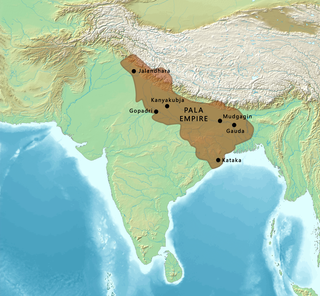Kumarapala may refer to:
- Kumarapala (Chaulukya dynasty) (1143–1172 CE), a Solanki king from western India
- Kumarapala (Pala king) (c. 1130–1140 CE), a Pala king from eastern India
Kumarapala may refer to:

Kannauj is a city, administrative headquarters and a municipal board or Nagar Palika Parishad in Kannauj district in the Indian state of Uttar Pradesh. The city's name is an evolved form of the classical name Kanyakubja. It was also known as Mahodaya during the time of Mihira Bhoja. It is situated 104 kilometres west of the state capital, Lucknow.

Hemachandra was a 12th century Indian Jain saint, scholar, poet, mathematician, philosopher, yogi, grammarian, law theorist, historian, lexicographer, rhetorician, logician, and prosodist. Noted as a prodigy by his contemporaries, he gained the title kalikālasarvajña, "the knower of all knowledge in his times" and father of the Gujarati language.

The Pāla Empire was an imperial power during the post-classical period in the Indian subcontinent, which originated in the region of Bengal. It is named after its ruling dynasty, whose rulers bore names ending with the suffix Pāla. The empire was founded with the election of Gopāla as the emperor of Gauda in late eighth century CE. The Pala stronghold was located in Bengal and eastern Bihar, which included the major cities of Gauḍa, Vikramapura, Pāṭaliputra, Monghyr, Somapura, Ramavati (Varendra), Tāmralipta and Jaggadala.

Kumarapala was an Indian king from the Chaulukya (Solanki) dynasty of Gujarat. He ruled present-day Gujarat and surrounding areas, from his capital Anahilapataka.
The migrations of people and influences to the North from Karnataka during 7th-12th century period is well attested by the sources but has not yet been studied carefully. This is known as "The Great Karnataka expansion"
Mallikarjuna was an Indian ruler from the Shilahara dynasty. He ruled northern Konkan from 1155–1170 CE.

The Pala dynasty of Kamarupa kingdom ruled from 900 CE. Like the Pala Empire of Bengal, the first ruler in this dynasty was elected, which probably explains the name of this dynasty "Pala". But unlike the Palas of Bengal, who were Buddhists, the Palas of Kamarupa were Hindus. The Hindu orthodoxy drew their lineage from the earlier Varman dynasty and thus ultimately from Narakasura i.e. Bhauma dynasty. The dynasty is unrelated to the previous Varman and Mlecchna dynasties.

Jainism has had a notable following in Gujarat. According to the 2011 Census of India, around 0.959% of the population of Gujarat is Jain. There are several old Jain temples that draw pilgrims from Jains around the world in places such as Palitana, Taranga, Sankheshwar, Idar.

Bikrampur was a pargana situated 19 kilometres (12 mi) south of Dhaka, the modern capital city of Bangladesh. In the present day, it is known as the Munshiganj District of Bangladesh. It is a historic region in Bengal and was a part of the Bhawal Estate.
Ramapala was the successor to the Pala king Shurapala II in the Bengal region of the Indian subcontinent, and fifteenth ruler of the Pala line.
Kumarapala was the successor to the Pala king Ramapala in the Bengal region of the Indian subcontinent, and sixteenth ruler of the Pala line reigning for 10 years. During his reign, he put down an uprising in Kamarupa by the governor Timgyadeva, eventually replacing him with Vaidyadeva. He was succeeded by his son Gopala IV, who ascended the throne as a child..

The Chaulukya dynasty, also Solanki dynasty, was a dynasty that ruled parts of what are now Gujarat and Rajasthan in north-western India, between c. 940 CE and c. 1244 CE. Their capital was located at Anahilavada. At times, their rule extended to the Malwa region in present-day Madhya Pradesh. The family is also known as the "Solanki dynasty" in the vernacular literature. They belonged to the Solanki clan of Rajputs.
Devapala may refer to:
Someshvara was an Indian king belonging to the Chahamana dynasty and ruled parts of present-day Rajasthan in north-western India. He was brought up at the Chaulukya court in Gujarat by his maternal relatives. After death of Prithviraja II, the Chahamana ministers brought him to the capital Ajmer and appointed him as the new king. He is said to have commissioned several Shiva temples in Ajmer, and is best known as the father of Prithviraja III.
Arnoraja was an Indian king belonging to the Shakambhari Chahamana dynasty. He ruled the Sapadalaksha country, which included parts of present-day Rajasthan in north-western India. Arnoraja defeated the Ghaznavid king Bahram Shah in the Slaughter of Turushkas near Ajmer, and also defeated several neighbouring Hindu kings including the Paramaras and the Tomaras. He had to face defeats against the Chaulukyas, and was ultimately killed by his own son, Jagaddeva.
Madanapala may refer to:
Āma was a medieval Indian king who ruled Kannauj and surrounding areas during the 8th and the 9th centuries. According to the Jain chronicles, he was the son and successor of Yashovarman.
Katuka-raja was an Indian king belonging to the Naddula Chahamana dynasty. He ruled the area around Naddula, after seizing the power from his relative Rayapala.
Alhana-deva was an Indian king belonging to the Naddula Chahamana dynasty. He ruled the area around Naddula, as a vassal of the Chaulukya king Kumarapala. During his reign, the Chahamanas of Shakambhari invaded Naddula, and Kumarapala replaced him with his own governors. Later, Kumarapala restored his rule in Naddula, as a result of his service in Chaulukya military campaigns.

The Samadhishvara Temple is a Hindu temple located in the Chittor Fort in Rajasthan, India. It is dedicated to Shiva, who is called "Samadhishvara", that is, "Lord of Samadhi". Epigraphic evidence suggests that the temple was constructed in the 11th century, and was further restored in the 13th and the 15th centuries.